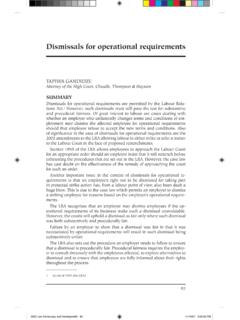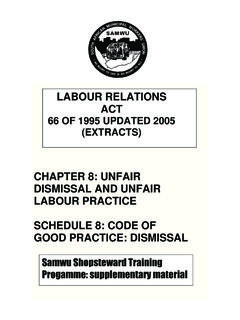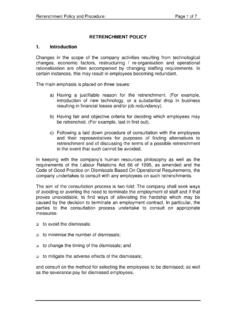Transcription of DISPUTE RESOLUTION PROCEDURE - SAWPA
1 SCHEDULE 2. DISPUTE RESOLUTION PROCEDURE . IN THE. NATIONAL BARGAINING COUNCIL FOR THE WOOD. AND PAPER SECTOR ( THE COUNCIL ). 1. TABLE OF CONTENTS. Introduction 1. Part 1: An overview of the DISPUTE RESOLUTION p[rocess . 2. Definiions 3. Part 2: disputes to be referred to the Council for conciliation 5. Categories of disputes .. 5. The referral for conciliation to the Council 6. The conciliation process at he council 7. Part 3: disputes to be referred to the Council for arbitration .8. Categories of disputes 8. The referral for arbitration to the Council ..9. The arbitration process at the Council ..9. Part 4: disputes to be referred to the Labour Court after conciliation at the Council ..12. Categories of disputes ..12. The referral for adjudication to the Labour Court ..12. The adjudication process at the Labour Court 13. Part 5: General .13. Powers of the Council's conciliators and arbitrators.]
2 13. disputes to be referred to the CCMA for conciliation 14. Private DISPUTE RESOLUTION procedures .15. 2. Introduction 1. This summary is designed to assist parties to refer a DISPUTE to the National Bargaining Council for the Wood and Paper Sector ( the Council ). Please read it carefully and if you need help phone the Council at . 2. This summary focuses on DISPUTE RESOLUTION in the Council and gives an overview of the most common disputes resolved by councils, and the CCMA or adjudicated in the Labour Court, to make sure that if you have a DISPUTE you refer it to the appropriate body. 3. This summary tells you what type of disputes you may refer- to the Council for conciliation;. to the Council for arbitration after conciliation by the council; or to the Labour Court for adjudication after conciliation by the council 4. This pamphlet sets out the relevant time periods and describes the conciliation process, the arbitration process and the powers of the Council's conciliators and arbitrators.
3 5. Definition of some terms outlined below: Automatically unfair dismissal: A dismissal is automatically unfair if the employer, in dismissing the employee, acts contrary to Section 5 10 or, if the reason for the dismissal is: (a) that the employee participated in or supported, or indicated an intention to participate in or support, a strike or protest action that complies with the provisions of Chapter V11. (b) that the employee refused, or indicated an intention to refuse, to do any work normally done by an employee who at the time was taking part in a strike that complies with provisions of Chapter IV. or was locked out, unless that work is necessary to prevent an actual danger to life, personal safety or health;. (c) to compel an employee to accept a demand in respect of any matter of mutual interest between the employer and the employee;. (d) that the employee took action, or indicated an intention to take action, against the employer by- i) exercising any right confered by this Act; or ii) participating in any proceedings in terms of this Act.
4 (e) the employees' pregnancy, intended pregnancy, or any reason related to pregnancy;. (f) that the employer unfairly discriminated against an employee, directly or indirectly, on any arbitrary ground, including but not limited to race, gender, sex, ethnic or social origin, colour, sexual orientation, age, disability, religion, conscience, belief, political opinion, culture, language, marital status or family responsibility. Constructive Dismissal; means that an employee resigned but the reason for the resignation was that the employer made the employees' working life intolerable. Unfair discrimination: No person may unfairly discriminate, directly or indirectly, against an employee, in any employment policy or practice, on one or more grounds, including race, gender, sex, pregnancy, marital status, family responsibility, ethnic or social origin, colour, sexual orientation, age , disability, religion, HIV status, conscience, belief, political opinion, culture, language and birth.
5 3. Part 1: An overview of the DISPUTE RESOLUTION process This chart shows you the route to follow to resolve a particular DISPUTE . The types of disputes are organized alphabetically Referral to disputes Referral for Referral for the Labour conciliation arbitration Court. Council CCMA Council CCMA. Agency Shop agreement (interpretation . or application Allocation of representatives to the . Council Automatically unfair dismissals . Benefits . Closed shop agreement (if the matter . concerns admission of a union to a closed shop agreement then Collective Agreement (interpretation or . application ). Collective Bargaining: Organizational . Rights Constructive dismissal . Council's Constitution . ( interpretation or application ). Demarcation DISPUTE . ( of sectors and areas of council ). Demotion . Disciplinary action . Disclosure of information . Essential Services DISPUTE . Formula for determining representatives.))
6 To council Freedom of association . Leave for union activities . Matter of mutual interest . Misconduct . Participation in union activities . Picketing . Poor work Performance . Promotion . Protest Action . Registration of unions and employer . organizations (appeals ). Re-instatement or re-employment . Retrenchment . Secondary Strike . Severance pay . Strikes . Suspension . 4. Referral to disputes Council CCMA Council CCMA the Labour Court Terms and conditions of employment . Training . Unfair Conduct (unfair labour practice ) . regarding promotion, demotion, training and benefits, suspension ( or disciplinary action short of dismissal ), reinstatement Unfair discrimination . (if the ( if the DISPUTE DISPUTE concerns does not dismissal ) concern dismissal ). Unilateral to terms and conditions of . employment Wages . Workplace Forums . Part 2: disputes to be referred to the council for conciliation Categories of disputes .
7 6. This chart sets out the categories of disputes that may be referred to the Council for conciliation. Examples of disputes are provided in each category. For further information you may refer to the relevant sections in legislation listed below. Category of disputes Examples Reference disputes about the interpretation or Participation in union activities Section 9 of the LRA. application of the provisions of Chapter II of the LRA called freedom of Association and general protection. disputes that form the subject matter Benefits S 64(1) of the LRA. of a proposed strike Matters of mutual interest Terms and conditions of employment Wages disputes about a unilateral change to Benefits S 64 (4) of the LRA. terms and conditions of employmenmt Matters of mutual interest Terms and conditions of employment Wages disputes in essential services Benefits S 74 of the LRA. Matters of mutual interest Terms and conditions of employment Wages 5.
8 Category of disputes Examples Reference disputes about unfair dismissals S 187, 189, 190, 191. Automatically unfair dismissals of the LRA. Misconduct Poor work performance Retrenchment disputes about unfair labour practice Benefits Items 2(1)(b), (c) and (UL P) Demotion (d) in Schedule 7 of Disciplinary Action the LRA. Promotion Reinstatement or re-employment Suspension Training disputes about unfair discrimination Unfair discrimination ( if the DISPUTE Sections 6 and 10 of concerns dismissal ) the Employment Equity Act. A DISPUTE concerning the Allocation of representatives to the Clause5 (2) read with determination or allocation of Council 5 (10 ) of the Council representatives of the number of persons representing either the Constitution employer's organizations or trade unions. Council's Constitution is ambiguous Clause 13 (1 ) of the A DISPUTE about the interpretation or Council's application of the Council's constitution.
9 Constitution. 6. The referral for conciliation to the Council. 7. The employee must refer the disputes in subclause in writing to the Council's secretary within a reasonable time ( recommend 30 days of the DISPUTE arising). about the interpretation or application of the provisions of Chapter II of the LRA ( Freedom of association and general protection ). disputes that form the subject matter of a proposed strike or locjout. in essential service;. disputes about severance pay;. about unfair labour practices 8. The employee must refer the disputes in sbclause in writing to the Council's secretary within thirty ( 30 ) days of dismissal- about unfair dismissals about unfair discrimination, if the discrimination concerns dismissal 5. 9. The employee must refer the disputes in subclause in writing to the Councils secretary within 30 days of a DISPUTE arising or within anytime period in any other relevant statute or collective agreement DISPUTE concerning the determination or allocation of representatives of the number of persons representing either an employers' organization or a trade union or.
10 DISPUTE about the interpretation or application of the Council's constitution 10. The Council may condone the late referral of a DISPUTE for conciliation on good cause shown 6. 11. The party who refers the DISPUTE must satisfy the council's secretary that a copy of the referral has been served on all other parties to the DISPUTE . _____. 5 If the DISPUTE does not concern a dismissal then it must be referred to the CCMA within 6 months after the act or omission that allegedly constitutes unfair discrimination 6 In a condonation application the employee must motivate the reasons why the council should condone the late referral. The condonation application must address the length of the delay the reason for the delay, any prejudice both parties might suffer and the prospects of success. 7. 12. Proof of service may be by way of a fax transmission slip, a post office registered slip, a copy of a signed receipt if hand delivered or an affidavit/.









